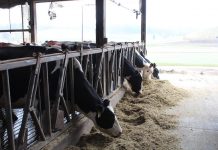We all know that a heifer is a female bovine animal that has not yet had a calf, well at least those of us that work in the dairy industry know that.
But then we use the term of “first lactation heifer,” which is not a “heifer “ but a young cow in her first lactation. Then, when an old cow kicks us or won’t go in the direction in which we are trying to move her, then she is an “old heifer.”
How can she be a “heifer” if she is an old cow? We may call her an “old heifer” because even though she is old, she is behaving like a heifer.
Act your age
In a sort of way, we are saying to the old cow, “you should act your age” — much like we might tell our kids. So, our language can be very confusing to those who don’t know cows, but those of us who work with cows understand our own language.
Of course, heifers can be a challenge at training for coming through the parlor for milking. Studies have been conducted on how the human-animal interaction prior to calving affects the behavioral reactions of the first lactation animals in the parlor.
The animal’s fear of humans, stress relative to the sounds and actions of the milking unit, and sometimes the discomfort of the milking unit on cows with considerable udder edema can lead to negative behavior by the cows during milking.
These behaviors can include kicking, flinching, stepping and the fear resulting in reduced milk let-down, thus increased milk residuals following milking.
Added frustration
These responses are indicative of an unpleasant experience by the cow and increase the risk of injury to the person doing the milking and can add to their frustration with the time required to focus on a single animal.
So improving the animal’s comfort within the milking parlor and reducing the fear of humans are important for optimal animal performance and experiences by the cow and the worker.
A study was conducted with 40 Friesian-cross heifers in New Zealand, whereby they were first categorized as low (LR) or high (HR) responders (low or high fear of humans) based on their exit time from a restraint device.
Half of the heifers in each group were then either left unattended in the pasture or at two weeks prior to expected calving date, they were trained to the sites and sounds of the parlor and the human interaction.
This training included four sessions over two days of exposure to the parlor. Within five days in milk and at 12 weeks in lactation, the behavior responses of cows were observed.The avoidance of humans by the cows was less for the trained LR than for trained HR. The trained HR stepped more than the trained LR.
The milk residual volumes (measured by administering 2 mL of oxytocin after milking and reattachment of the milker unit one minute after injection) was lower during the first week of lactation in trained heifers.
Over the first eight months of lactation, milking duration was lower and milk flow rates were higher for trained heifers. Overall, training appeared to improve the behavioral responses of first-lactation cows, but this was somewhat dependent on the temperament of the heifers in that the HR heifers showed less improvement.
Improved response
Based on the New Zealand and several other studies, positive human-animal interaction can improve the behavioral responses of first-lactation animals to the initiation of the process of being milked.It’s at this time that the human-animal interaction intensifies after a period of less engagement, the animals have gone through the stress of calving, and then introduced to a strange environment with new sounds and physical contact.
Whether heifers are introduced to the parlor prior to calving, it is very important that the employees milking these “heifers” that are “cows” provide a gentle positive interaction.It has been shown by Australian research that a single negative encounter by the animal with humans takes many positive engagements to reduce the fear of the animals to humans.
Also, something to take from the New Zealand study is that heifers with bad temperament will continue to response less positively to the milking process after calving.
Many farms today are holding onto more replacement heifers than needed, thus the heifers of lower genetic merit and those with bad temperament need to be sold prior to calving.
This will reduce the volume of feed needed on the farm, provide the use of resources for the animals most valuable to the farm, and provide for the early removal of animals with the most likelihood of being culled after calving.
So, the adage of “Keep the Best, and Sell the Rest” also applies to heifers, before they become cows.
STAY INFORMED. SIGN UP!
Up-to-date agriculture news in your inbox!










